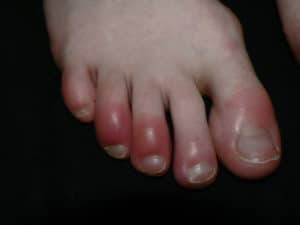Contents
What are Red Feet?
You depend on your feet for almost all the work you do in your day-to-day life, for example, walking, standing, climbing stairs, running, and some other activities including becoming support for your whole body. The feet are made up of several complex and complicated parts such as bone, skin, muscles, and cartilage. And all these get affected in the same manner that causes red feet. However, most causes of red feet are easily curable and can be easily treated at home, some of them might turn worse and need intense examinations and treatment from experts.
Characteristics of Red Feet/Foot Redness
Redness in feet can vary based on the following characteristics:
- Gradual or sudden: The redness can occur within a second in case you get hit or you drop something on your feet. But the color might come into visibility even after hours of the hit.
- Persistent and Intermittent: Sometimes it so happens that that redness in the feet plays hide and seek. That is, it might happen that the affected area appears red at once and then goes back to normal color. And then again appear after sometimes.
Covid and Red Feet (COVID toes)
The symptoms of coronavirus are not new to any of us. Some of them are:
- Dry cough
- Fever
- Shortness of breath
- Weakness
- Body pain
Apart from these, scientists have come up with another potential symptom of the infection, that is, red feet. Or to be more specific, the symptom appears as red bumps on the toes causing itchiness.
Symptoms of Red Feet
Well, red feet themselves are a symptom of several foot problems such as ulcers and sores. Some of the symptoms that accompany redness in the feet are:
- Numbness
- Difficulty walking
- Chills
- Tingling
- Joint pain
- Swelling
- Itchiness
- Pain
- Tenderness
- Burning in the affected area
Causes of Red Feet
Red feet can appear due to several reasons. Also, you might have noticed that discoloration is not the only symptom of red feet. Causes of red feet are:
Skin Infection:

This is a condition that occurs when bacteria surviving in your skin moves into your skin itself. Bacteria when gets into the skin results in cellulitis, a common skin infection.
Apart from redness in the feet, the following are the symptoms of skin infections:
- Toe and foot pain
- Toe and foot swelling.
- Fever
Injury:

Any kind of hitting or dropping off something on the feet can be enough to turn them red. The injuries may create pressure, swelling, and pain including redness.
Inflammation:

This occurs due to certain substances. When your skin comes across substances such as gasoline or detergents like soaps and bleach, it gets inflamed. Some other symptoms of skin inflammation are:
- Foot and toe pain
- Rough/dry skin
Allergic Contact Dermatitis:
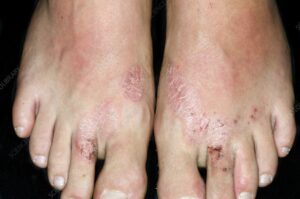
Allergens such as poison ivy and metals such as nickel, when coming in contact with your skin, cause irritation and also makes it inflamed.
In addition to redness, the other symptoms are:
- Toe and foot itchiness
- Scabs on toes and feet.
Gout:

Gout is a form of arthritis and causes redness in the feet. Some of the other symptoms are:
- Pain in joint and muscle
- Stiffness and swelling in joints
- Swelling in toes.
Nail Infection:
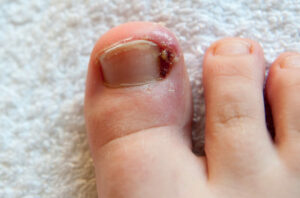
Known as paronychia in medical terms, nail infection is an infection that occurs when your toenail ends bend or fold. Usually, this is the result of bacteria called Staphylococcus aureus, or a fungus.
Peripheral vascular disease:
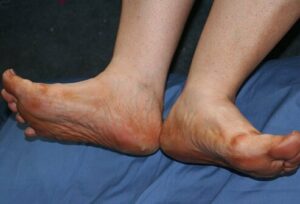
The biggest reason for this kind of disease is the poor flow of blood in the affected area. And this happens because of clogged arteries, a condition called atherosclerosis.
Symptoms include:
- Toes and feet redness
- Toes and feet itchiness
Athlete’s foot:
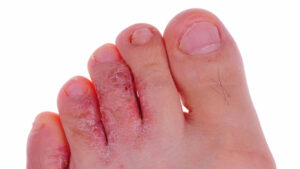
Another name for Athlete’s foot is Tinea pedis. It is basically an infection, a fungal infection actually.
Symptoms of athlete’s foot include:
- Itchiness in the affected area
- Peeling between toes.
Treatment for Red Foot
The treatment will depend on the intensity of the wound or the cause of redness. In case, you don’t have any severe symptoms such as worsening condition or spreading of the wound, you can treat it at home:
1. Warm or cold compress:
Redness can be calmed down by applying a warm compress. It can reduce inflammation and will provide relief if your feet have been exposed to cold temperatures for a longer period of time. Or you can go for a cold compress also to reduce redness and irritation.
2. Over-the-counter medicine:
There are quite a few medicines available out there that can help you deal with and relax the pain, swelling, and redness of your feet. Some are:
- ibuprofen (Advil, Motrin),
- naproxen (Aleve), and
- Aspirin
3. Fluid-intake:
Hydration helps if your red feet are due to some infectious cause. This helps especially when you have fever also as one of the symptoms.
When Red Foot is an Emergency?
You should seek immediate medical help if you are facing the following issues in addition to the redness of the feet:
- Rapidly spreading and worsening of the redness
- Increasing intensity of the foot pain
- Nausea
- Vomiting
- Difficulty breathing
- High body temperature (fever).
Note: Be extra careful if you are suffering from diseases like diabetes and kidney disease. Patients are dependent on chemotherapy or immunosuppressive medications.
What do your feet say about your health?
Well, if seen through the light of hierarchy, our feet are the last part of the body. but if we look into this with a different light, our feet bear the burden of the whole body. it lets us stand. also, the feet tell a lot about your health-related conditions. Let’s find out which condition notifies what:
Cold Feet
- smoking,
- high blood pressure,
- or heart disease.
Foot Pain
- intense exercise
- osteoporosis
Red, White & Blue Toes
There is a condition wherein your toes turn white, then bluish, and then reddish again. This condition is called Raynaud’s disease. Vasospasms, narrowing of the skin cause it. And stress or changes in temperature causes vasospasms.
Heel Pain
Inflammation in the area where the long ligament connects to the heel bone can be the reason. You generally experience the pain when you wake in the morning and put pressure on the feet to stand.
Clubbed toes
However, in some families, the shape of the nails is clubbed naturally. Clubbed toes indicate underlying lung disease, heart disease, or even some digestive disorders. It also signals infections.
Tips For Healthy Foot
- Don’t leave your foot unchecked even for one day. You need to avoid cuts and injuries. Checking for swelling, redness, blisters, corns, calluses, if any should be caught initially itself. Ask for someone’s help to check the bottom side of the feet. You can use a mirror also.
- Wash your feet every day. Use warm water to do so. But never soak your foot. You just need to wash them, make them completely dry and don’t forget to apply lotions.
- Whenever needed, trim your toenails. Don’t wait for the time to grow them long enough to cause cuts.
- Use diabetes-friendly footwear and socks. While shopping for shoes and socks, you need to be a little more attentive if you are a diabetic. Go for full coverage shoes with more depth in the toe box.
- Never step out barefoot. However, you should not move barefoot even when you are indoors.
- Go easy on your foot while exercising.
Conclusion
Here we have reached the end. All you need to know is that it is your body and it will be you taking care of it lifelong. You need to be very sure about the impact that certain edible things are going to put on your body. The wisest option is to make a balanced diet chart for yourself and make a note of everything that helps you in a positive manner. More importantly, you should be aware of the methods by which you can monitor your sugar level timely. Hope you ended up having a productive time reading the above article about blood sugar levels.
A Word From MantraCare
If you are facing diabetes-related issues, MantraCare is here to help. Book your free trial online diabetes consultation session now to connect with a specialist diabetologist.
